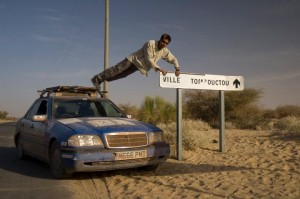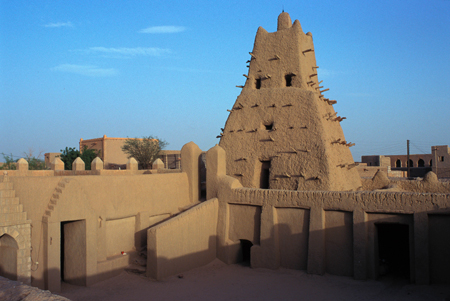“Behave, or I’ll send you to Timbuktu” my grandmother would threaten when I was being scolded as a child… Throughout my childhood, I grew up with differing views of Timbuktu, on one side I was being told that Timbuktu is a fabled city of legend and myth, shrouded in mistery and at the end of the world. On the other side, I was told that Timbutku was the most prominent centre for trade in Africa in its days.
Both are very accurate.

Timbutu, now in Mali, used to be the center of trade in Africa. While in Timbuktu, I was told
Gold came from the South,
Religion, from the East
Salt, from the North
Slaves, from the West…
but Divine Knowledge, that can only be found in Timbuktu!
Which really sums up quite well Timbuktu’s past. On the souther border of the Sahara desert, next to the Niger, Timbuktu served as both the last outpost of civilisation before the long convoys into the desert and as an arrival for the long convoys from the North. Trade thrived, gold and salt were traded in equal quantities at one point. Legend has it that Kankan Musa, the emperor of the Mali empire, caused the price of gold in Egypt to plummet through his lavish gifts after his trip to mecca. Another story tells of his cousin, who may have been to South America long before Columbus.
While thriving, knowledge was considered the true wealth of Timbuktu. Libraries litter the city, and each family has a stash of books, some dating back hundreds of years, as the family heirlooms. The dry, warm weather in the desert has helped preserve the books along with a lot of care from their owners.
That said, in the 16th and 17th Centuries, the desert trade routes started drying up – and trade started preferring the seas and oceans that surround the continent. Since then, Timbuktu has started it’s decline into mistery.
They transformed their garments and dwellings,
and ceasing to be Timbuktu the Great,
they became Timbuktu the Mysterious.
– Felix Dubois, Timbuctoo the Mysterious (1896)
Now, the city is a bustling center with very few visitors. Or at least, it was when we visited. Threats from terrorism (Al Queda in Mahgreb mainly), recent beheadings, bombings and kidnappings meant that the foreigners had abandoned the city faster than the tourists. The museums were closed (though the proud guardians were quite happy to open them to show the true wealth of the city). The tourist office was closed, and only after a few hours of enquiring did the man running it turn up in an old C250, stunned to see tourists almost as much as we were by Timbuktu. Hoarded of people offering to be guides turned up and tried to sell their services. The hotel we had picked in the guide book had been abandoned by its French owners, and the watchman offered to let us stay in the now empty building, though without light or water.
The three main and oldest mosques are absolutely stunning – though non-Muslims are not allowed inside. On the other hand, there are a plethora of libraries, museums and houses that you can visit. Each has an entry fee, or a tip to the guardian.
The culture is a true mix, there is native African, Songhrai, Berber, Touareg, Mandinko, Wolof, Fula, Arab African, Islam, Christianity, Hinduism, and just about everything else in one large melting pot. Absolutely amazing. And the dunes on the outside…
Pictures will come soon… but if you want to keep reading, head over to www.TeamBookTwo.com for the story of the rally that brought us to one of the most interesting cities on the planet. Also, make sure you have a look at the “Cross the Sahara” challenge on this site!
And a short video taken while we were totally lost in Timbuktu looking for a hotel:

